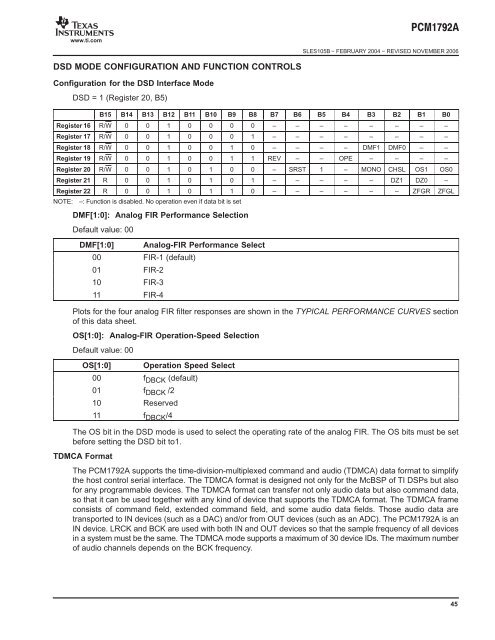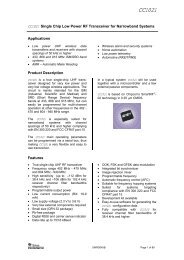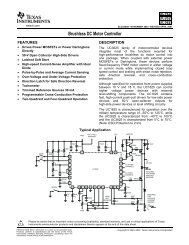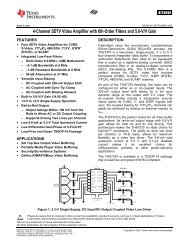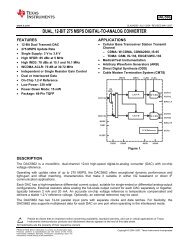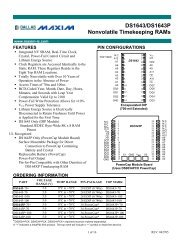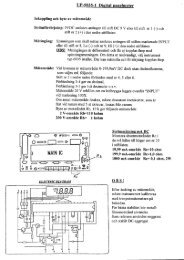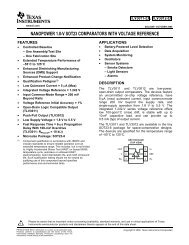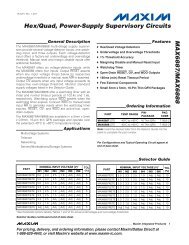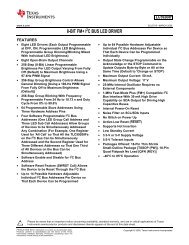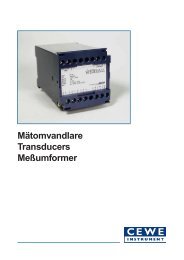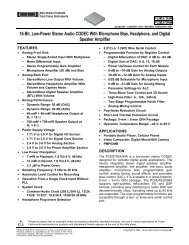24-Bit, 192-kHz Sampling, Advanced Segment, Audio Stereo DAC ...
24-Bit, 192-kHz Sampling, Advanced Segment, Audio Stereo DAC ...
24-Bit, 192-kHz Sampling, Advanced Segment, Audio Stereo DAC ...
Create successful ePaper yourself
Turn your PDF publications into a flip-book with our unique Google optimized e-Paper software.
www.ti.com<br />
DSD MODE CONFIGURATION AND FUNCTION CONTROLS<br />
Configuration for the DSD Interface Mode<br />
DSD = 1 (Register 20, B5)<br />
<br />
SLES105B − FEBRUARY 2004 − REVISED NOVEMBER 2006<br />
B15 B14 B13 B12 B11 B10 B9 B8 B7 B6 B5 B4 B3 B2 B1 B0<br />
Register 16 R/W 0 0 1 0 0 0 0 – – – – – – – –<br />
Register 17 R/W 0 0 1 0 0 0 1 – – – – – – – –<br />
Register 18 R/W 0 0 1 0 0 1 0 – – – – DMF1 DMF0 – –<br />
Register 19 R/W 0 0 1 0 0 1 1 REV – – OPE – – – –<br />
Register 20 R/W 0 0 1 0 1 0 0 – SRST 1 – MONO CHSL OS1 OS0<br />
Register 21 R 0 0 1 0 1 0 1 – – – – – DZ1 DZ0 –<br />
Register 22 R 0 0 1 0 1 1 0 – – – – – – ZFGR ZFGL<br />
NOTE: –: Function is disabled. No operation even if data bit is set<br />
DMF[1:0]: Analog FIR Performance Selection<br />
Default value: 00<br />
DMF[1:0] Analog-FIR Performance Select<br />
00 FIR-1 (default)<br />
01 FIR-2<br />
10 FIR-3<br />
11 FIR-4<br />
Plots for the four analog FIR filter responses are shown in the TYPICAL PERFORMANCE CURVES section<br />
of this data sheet.<br />
OS[1:0]: Analog-FIR Operation-Speed Selection<br />
Default value: 00<br />
OS[1:0] Operation Speed Select<br />
00 fDBCK (default)<br />
01 fDBCK /2<br />
10 Reserved<br />
11 f DBCK/4<br />
The OS bit in the DSD mode is used to select the operating rate of the analog FIR. The OS bits must be set<br />
before setting the DSD bit to1.<br />
TDMCA Format<br />
The PCM1792A supports the time-division-multiplexed command and audio (TDMCA) data format to simplify<br />
the host control serial interface. The TDMCA format is designed not only for the McBSP of TI DSPs but also<br />
for any programmable devices. The TDMCA format can transfer not only audio data but also command data,<br />
so that it can be used together with any kind of device that supports the TDMCA format. The TDMCA frame<br />
consists of command field, extended command field, and some audio data fields. Those audio data are<br />
transported to IN devices (such as a <strong>DAC</strong>) and/or from OUT devices (such as an ADC). The PCM1792A is an<br />
IN device. LRCK and BCK are used with both IN and OUT devices so that the sample frequency of all devices<br />
in a system must be the same. The TDMCA mode supports a maximum of 30 device IDs. The maximum number<br />
of audio channels depends on the BCK frequency.<br />
45


